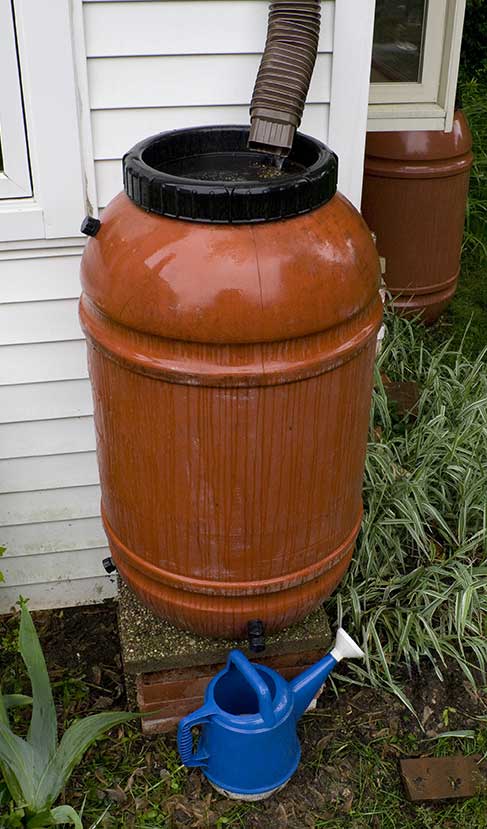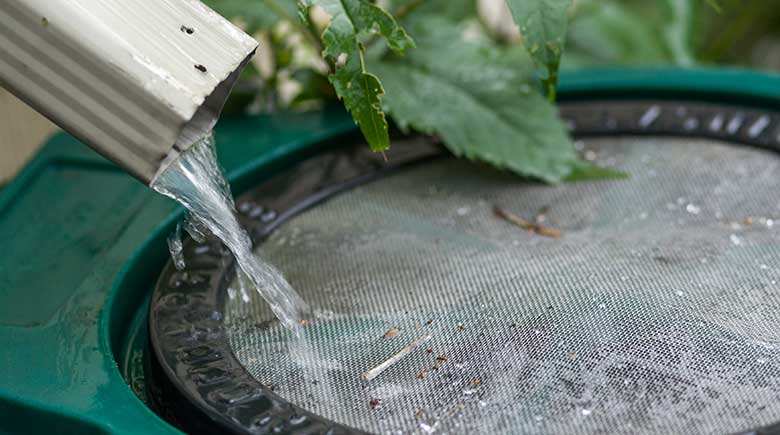Stop Runoff
Use a Rain Barrel
 Rain barrel usage can be important to the overall success of the stormwater management system. The benefits of using a rain barrel include:
Rain barrel usage can be important to the overall success of the stormwater management system. The benefits of using a rain barrel include:
- Stormwater that washes off rooftops and into downspouts is caught and retained.
- Homeowners use the water in the rain barrel as needed during the growing season.
- Water can be reused as needed in the garden or lawn landscape.
- Reduces stormwater runoff and pollution by providing treatment to the “first flush” of contaminants.
- Easy Installation—suitable for all property types.
- Reduces water bills by not using potable water for irrigation.
- Water generated is very soft (low in minerals), which is good for plant growth.
The proper design, siting and maintenance practices are necessary to ensure that the rain barrel is functioning appropriately and not becoming a nuisance or mosquito breeding ground in the development. The following guidance is intended to provide the proper siting, mosquito control and maintenance practices for your rain barrel.
Finding the best location for your rain barrel
To find the best location for your rain barrel, the following techniques are recommended:
- Place rain barrel on a hard, level, and pervious surface. Concrete blocks, bricks, decorative blocks, or flagstones work well as a base.
- Locate rain barrel at downspout nearest to the garden you want to irrigate.
- Rain barrels work using gravity to drain – The garden to be irrigated should be lower in elevation that the rain barrel.
- Ensure that the rain barrel overflow location directs water towards your yard and not your neighbors.
What about those pesky mosquitoes?
Many homeowners worry that rain barrels will create a breeding ground for mosquitoes. The following is a list of tried and trusted techniques that can be employed to control mosquitoes:
- Ensure that the mosquito proof screen on the rain barrel is installed and functioning correctly.
- Ensure that the base is pervious, so overflow does not collect and leave standing water for mosquito breeding.
- Inspect rain barrel weekly—ensure that the lid is securely closed and the water is free of organic material.
- Mosquito larvae require 6-9 days to hatch. Completely drain the barrel once per week and clean if necessary to prevent the formation of stag11ant water.

When properly encased with a mosquito proof screen, rain barrels will keep out any mosquitoes from breeding.
How do I take care of my rain barrel?
To properly care for your rain barrel, the following techniques are recommended:
- Keep spigot closed when not using water.
- Routinely inspect gutters, downspouts, rain barrel intake and mosquito screens for debris.
- Keep lid secured and screens clear of debris. Make sure the overflow tube and hose are functioning correctly.
- If odours develop, drain the rain barrel and spray with a hose until clean.
- Completely drain rain barrel before winter—leave spigot open during the cold months so water does not accumulate and freeze.
- Ensure that the overflow is draining properly and not causing erosion of the rain barrel base. An example overflow valve is shown in the above figure.
- Rain barrel water is not potable—do not drink the water.
